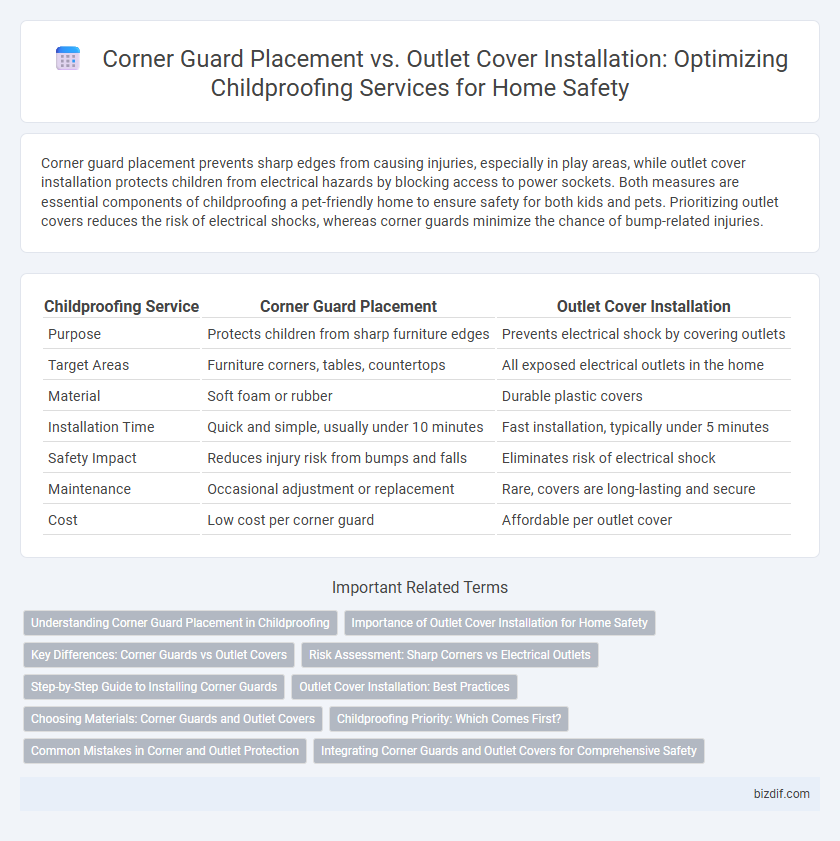Corner guard placement prevents sharp edges from causing injuries, especially in play areas, while outlet cover installation protects children from electrical hazards by blocking access to power sockets. Both measures are essential components of childproofing a pet-friendly home to ensure safety for both kids and pets. Prioritizing outlet covers reduces the risk of electrical shocks, whereas corner guards minimize the chance of bump-related injuries.
Table of Comparison
| Childproofing Service | Corner Guard Placement | Outlet Cover Installation |
|---|---|---|
| Purpose | Protects children from sharp furniture edges | Prevents electrical shock by covering outlets |
| Target Areas | Furniture corners, tables, countertops | All exposed electrical outlets in the home |
| Material | Soft foam or rubber | Durable plastic covers |
| Installation Time | Quick and simple, usually under 10 minutes | Fast installation, typically under 5 minutes |
| Safety Impact | Reduces injury risk from bumps and falls | Eliminates risk of electrical shock |
| Maintenance | Occasional adjustment or replacement | Rare, covers are long-lasting and secure |
| Cost | Low cost per corner guard | Affordable per outlet cover |
Understanding Corner Guard Placement in Childproofing
Corner guard placement in childproofing involves strategically positioning soft, cushioned guards on sharp furniture edges and corners to prevent injuries from accidental bumps. Proper installation requires measuring the dimensions of furniture corners and ensuring secure adhesion to withstand repeated contact. This method differs from outlet cover installation, which focuses on electrical safety by blocking access to power outlets, whereas corner guards primarily reduce impact hazards.
Importance of Outlet Cover Installation for Home Safety
Outlet cover installation is crucial in preventing electrical accidents by restricting children's access to electrical sockets, a common household hazard. Unlike corner guards that protect from sharp edges, outlet covers directly reduce the risk of electrical shock and burns. Ensuring all outlets are fitted with secure covers significantly enhances overall home safety for children.
Key Differences: Corner Guards vs Outlet Covers
Corner guards provide physical protection by cushioning sharp edges on furniture and walls to prevent injuries, while outlet covers block electrical sockets to safeguard children from electrical hazards. Corner guards are typically made from soft, impact-absorbing materials like silicone or rubber, whereas outlet covers are usually plastic inserts or sliding covers designed to fit securely into or over electrical outlets. Installing corner guards reduces risk of bruises and cuts from falls, whereas outlet covers primarily prevent electrical shocks and burns by restricting access to live sockets.
Risk Assessment: Sharp Corners vs Electrical Outlets
Risk assessment in childproofing prioritizes identifying the hazards posed by sharp corners and electrical outlets. Corner guard placement reduces injury from bumps and cuts by cushioning sharp furniture edges, while outlet cover installation prevents electrical shocks and burns by blocking access to live sockets. Evaluating the child's environment and behavior helps determine which protection method addresses the most immediate safety risks.
Step-by-Step Guide to Installing Corner Guards
Installing corner guards begins by thoroughly cleaning the edges of furniture or walls to ensure proper adhesion. Peel the backing off the corner guard adhesive strip and firmly press it onto the corner, holding for 30 seconds to secure a strong bond. Regularly inspect the guards for wear and replace them if adhesive weakens, maintaining effective childproofing.
Outlet Cover Installation: Best Practices
Outlet cover installation requires selecting covers that fit securely over all types of electrical outlets to prevent children's access to live wires. Placement should ensure every accessible outlet within a child's reach is covered, including rarely used or hidden outlets behind furniture. Choosing tamper-resistant or sliding outlet covers enhances safety by allowing adult access while blocking curious children effectively.
Choosing Materials: Corner Guards and Outlet Covers
Choosing materials for corner guards and outlet covers significantly impacts child safety and durability. Corner guards made from soft, impact-absorbing silicone or rubber provide effective cushioning against sharp edges, while outlet covers crafted from sturdy, tamper-resistant plastic prevent electrical hazards. Selecting non-toxic, BPA-free materials ensures both products are safe for children while offering long-lasting protection in childproofing environments.
Childproofing Priority: Which Comes First?
Corner guard placement should be prioritized before outlet cover installation in childproofing, as sharp furniture edges pose a more immediate risk of injury to toddlers learning to walk. Securing corners with protective guards reduces the chance of serious cuts or bruises from falls, which are common in early childhood development stages. While outlet covers are essential for preventing electrical hazards, corner guards address more frequent and immediate physical dangers.
Common Mistakes in Corner and Outlet Protection
Common mistakes in corner guard placement include improper sizing and inadequate adhesive use, which can lead to insufficient protection or guards falling off. Outlet cover installation errors often involve using non-childproof covers or leaving covers partially open, increasing risk of electrical hazards. Ensuring secure, appropriate corner guards and fully locked outlet covers optimizes child safety in the home environment.
Integrating Corner Guards and Outlet Covers for Comprehensive Safety
Integrating corner guards and outlet covers creates a comprehensive childproofing solution that simultaneously protects against sharp edges and electrical hazards. Corner guards, typically made from durable, shock-absorbent materials, prevent injuries from furniture corners, while outlet covers block access to electrical sockets, reducing the risk of electric shock. Together, these safety devices form an essential barrier that enhances overall home safety for toddlers and young children.
Corner guard placement vs Outlet cover installation Infographic

 bizdif.com
bizdif.com